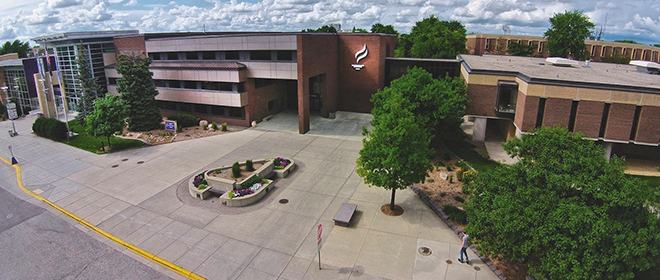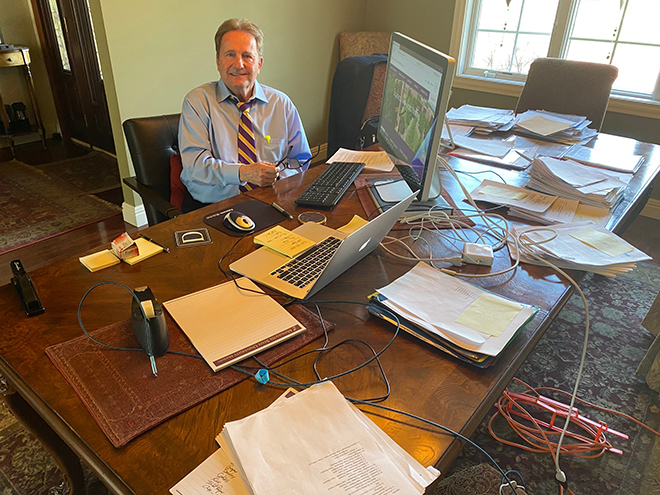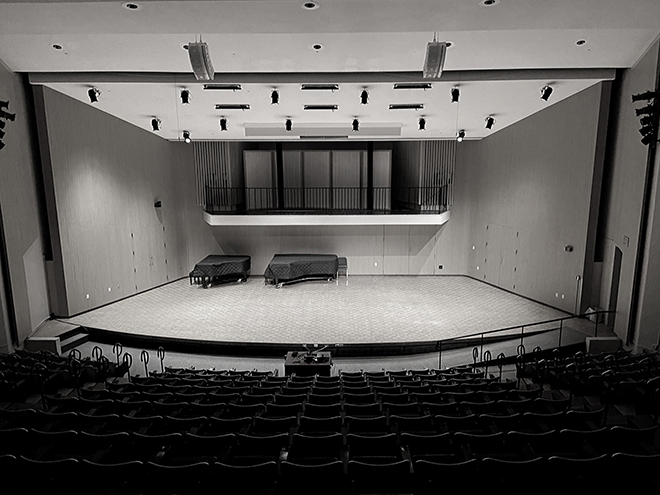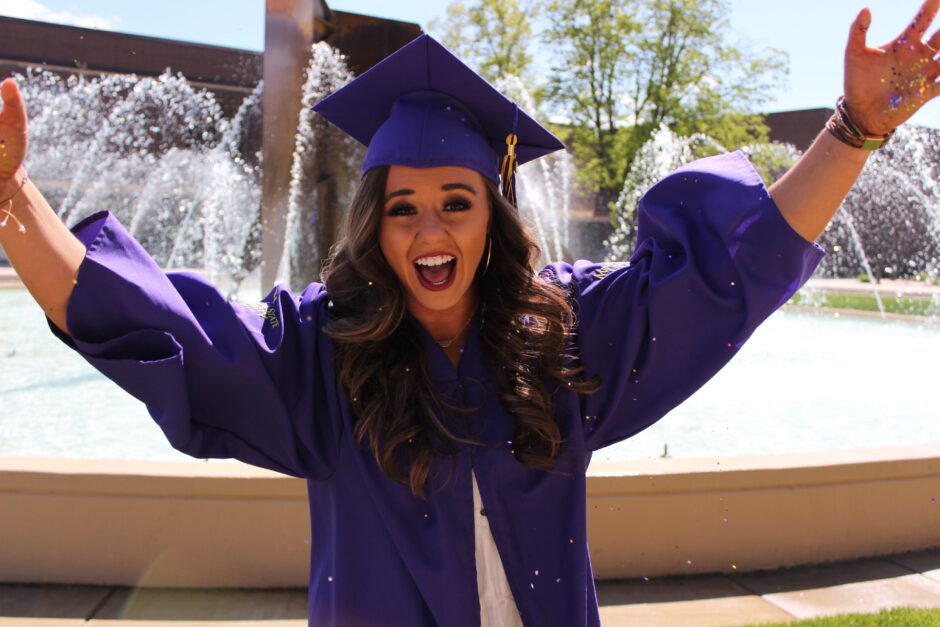If there was one moment when things shifted, when he knew the coronavirus was sending Minnesota State University, Mankato into unfamiliar and unsettling territory, President Richard Davenport said it was when Gov. Tim Walz ordered Minnesotans to stay at home on March 27.
All right, Davenport remembers thinking. We’re not looking at a one-week, two-week turnaround, this is going to be a longer–term ordeal.
March 2020 saw the most drastic change in the University’s 150 years. College life became anything but, as buildings emptied and more than 3,000 classes shifted from University classrooms, labs and lecture halls to the homes of students and professors, connected solely online. Safety concerns required a pivot into what, for many, were untested areas of teaching and learning.
And it worked.
It worked with a speed and cohesion that astounded most anyone accustomed to the ordinarily slow pace of change when it comes to university policy and practices.
“It was an amazing experience to work through,” said Rick Straka, vice president of Finance and Administration. “Basically, in a period of seven business days we took the majority of this university virtual.”

Anxiety and confusion reared, to be sure. Yet, as always, Maverick spirit prevailed.
Blocked out of the art studio, senior Sam Brown’s undergraduate research grant project involved a six-foot-by-six-foot painting he no longer could access. He scaled down his work and kept creating.
Nick Euell, a student in the Integrated Business Experience (in which students create actual, real-world businesses), found his start-up stuck with new products he had intended to sell at campus events in the spring, all of which were cancelled. He Zoomed his business partners and established an alternative sales plan focused on family and friends. It worked.

Biology instructor Rachel Cohen had to figure out how the first-year students in her biology research course were going to fare in lab units without access to a lab. She had students analyze existing data and arranged for online lab team meetings.
Similar situations—and unique solutions—popped up daily, as keeping students, faculty and staff safe during the pandemic became the primary goal of University leadership.
Within a matter of weeks, Davenport and the Minnesota State system went from communicating caution to making announcements about extending spring break, ending in-class instruction and having faculty and staff work from home.
“There was hardly any time to think about it. It had to be done,” Davenport said. “I don’t think anybody commiserated about it, because it was something that was essential. It’s like a tornado warning, you don’t think twice. You just move ahead for the safety and well-being of all our staff and students.”
PRIORITIES
When the World Health Organization declared the coronavirus a pandemic on March 12, the University assembled a pandemic response team with representation from administration, student housing and health services.
“We started to have these conversations that now seem quaint, about how we may need to do this or that,” said Interim Provost Matt Cecil. “And next thing you know we’re all working from home.”
Appointed by Davenport to the Interim Provost position in April, Cecil was just one month into his new role of when he was confronted with how to help guide the University’s response to the pandemic.
“Luckily I’d been here for four years, so I knew the players, I knew who to work with and how to work with people,” said Cecil, who had been the dean of the College of Arts and Humanities before the appointment. “But yeah, it was a little bit of a shock.”
A communications professional prior to his academic career, Cecil’s work suddenly involved announcing work-from-home directives to faculty and making sure to keep communication channels open. Cecil worked on empathy and problem-solving with staff and faculty while Davenport addressed students, families and the larger campus community, including alumni and donors.
Lindsey Beyer, director of Web Marketing, was charged with creating and maintaining the University’s COVID-19 web site. The site has been live since March 3, serving as an immediate source for information regarding the University’s response to the pandemic. It grew quickly from a page to a rich and interactive site that invites questions and provides guidance for effectively navigating online learning.
“They’ve been working around the clock to figure out the best way forward,” Beyer said, “and to get people answers not only as quickly as possible, but answers that really address their needs.”
KMSU, the university radio station operating out of the Alumni and Foundation Center, took on several new responsibilities under direction of station manager Dwayne Megaw – a commercial radio veteran who joined the University in July 2019.
“We tried to step it up from both perspectives, from serving the geographic community, southern Minnesota, but also the campus community as well,” Megaw said. “Because we were in a state of emergency we needed to let folks know what was going on.” The station airs Gov. Tim Walz’s daily press briefings which often include officials in emergency management, health and economic development.
“It makes sense to air that on a daily basis, because you get all of the information delivered in one place by the people who know what they’re talking about,” Megaw said. In the early weeks of the transitioning, Cecil was a weekly guest on staffer Karen Wright’s morning radio show.
“It was great to be able to have him on in his calm, cool and collected demeanor passing along the information that was vital for students to figure out what was going on,” Megaw said.
STAYING IN TOUCH
Once students were no longer on campus, an early goal was to contact each one to offer support. That task fell to the division of Student Success, which recruited staff from around the University to make calls, take questions and work to get them answered. Within a month, every student was called.
Lynn Akey, the vice president of Student Success, Analytics and Integrated Planning, put out a campus-wide call to staff asking for help in a goal to call and talk with every student.
“We were inundated,” said Amy Staloch, the communications director for the division. More than 60 staff from various walks of campus life pitched in to call students with a message: We’re here.
“We may physically not be in the same space, but we’re going to take the time, and we’re going to show you that we want to make sure that you feel like you’re still connected and being part of the Maverick family,” Staloch said.
Through the University’s admissions office, calls and emails went out to incoming students as well. Though not yet taking courses, new enrollee Ainslee Hemmen said her many questions received immediate answers and eased a lot of her stress wondering what was happening at her new University.
“I ended up being able to get every single one of my weird little questions answered, down to the dimensions of my dorm room,” she said. “I had a really good experience getting my questions answered in a timely manner by them.”
Davenport said he was contacted daily with questions from students—many of whom were pleasantly surprised to hear back from him, he said.
“We look at their problem and say OK, we’re going to figure this out,” Davenport said. “We don’t wait for two days. We do it almost immediately, and I think it gives some sense of relief and confidence in the families that are sending their sons and daughters here.”
PLANS IN PLACE
The University had emergency protocols in place for a range of crises including pandemics, Davenport said. It was a helpful framework, he said, but it was also just the beginning.
“It’s one thing to have something on paper. It’s another thing to actually implement,” he said. “From day to day we had continuous reports from the [Minnesota State] system office and recommendations, and it really fell heavy on the shoulders of the administration, faculty and staff to make this happen.”
The President’s cabinet, the pandemic response team and the deans and department heads all worked in concert, Davenport said, understanding the decisions they were making were those of life and death.
“The health of our students, faculty and staff and others—that was foremost in our mind when we began,” he said.
As the largest four-year institution in the Minnesota State university system, Minnesota State Mankato played a key role in the system’s decisions, Cecil said.
“They know the big picture very well, but we know what has to happen on the ground for these things to be functional and viable, and that’s where I think our campus has had a lot of influence,” he said.
Davenport added that he met regularly with system Chancellor Devinder Malhotra and his cabinet.
“The reality is we aren’t in this alone, we’re part of a major team,” Davenport said. “Chancellor Malhotra has really stepped up to the plate, offering his leadership and his intelligence and making sure he involved all of us in trying to come up with solutions.”
SHARED LOSSES, NEW CELEBRATIONS
In terms of the campus community’s collective heartbreak, it seemed nothing would top that of the Maverick men’s hockey team being denied the chance to play for the NCAA championship. The Mavericks were set to play in the WCHA conference semifinals at home when the NCAA called off the season due to coronavirus concerns.
But the March 19 announcement by Davenport that spring commencement would be cancelled was even more profoundly disappointing for many at the University. A team led by Vice President of Advancement Kent Stanley put together a plan to help make graduating students feel special even if they couldn’t walk across the stage as they had expected.
Boxes containing congratulatory Maverick-themed gifts were assembled and sent to each of the almost 2,200 graduates. While no one claims it’s any substitute for the real thing, a message of congratulations was nonetheless important to send, Davenport said. Equally as important is a special commencement ceremony planned for December.
“To me it’s saying we know what we have in mind for you right now in no way could equal the real commencement, but we really want those students to feel they’re welcome back in December,” he said.
A NEW AFTERWARD
Fall enrollment numbers will reveal the pandemic’s financial toll on the University. There’s little doubt enrollment will drop, Davenport said, although some creative thinking continues to help counter it. Initiatives such as offering a full semester of online learning to international students, generating scholarships for underrepresented students less likely to rebound financially and offering classes in the Minneapolis-St. Paul area for students who live in or near the Twin Cities are a few of the ideas discussed to shore up enrollment and serve students.

Before the crisis hit, summer and fall enrollment looked promising. Summer enrollment stood ahead of the prior year’s summer numbers, and indicators for fall looked good. Straka said the University was ahead in intent-to-enroll statistics as well as residence hall room deposits. “There were a number of things that were looking very positive for us,” he said.
As many await the fall numbers to better gauge what happens next, the experience thus far in this unprecedented process has provided many at the University with a new appreciation of how much can be accomplished under extraordinary, if not historic circumstances.
“It does say a lot about our university,” Davenport said. “I think it makes a very strong statement that we work together for the well-being of others. I think that’s one of the reasons that our institution has been doing so well over the years.”
From his parents’ cabin in Elk River, sophomore Nick Euell managed to have his IBE business’ sales turn a profit – even with weeks left in the quiet semester. He had enthusiastic praise for the business instructors and the University’s leadership overall.
“The university itself has reached out with any help they can,” he said. “The whole point of it is a real-world experience. And this is the most real-world experience I could think of.”

Speak Your Mind